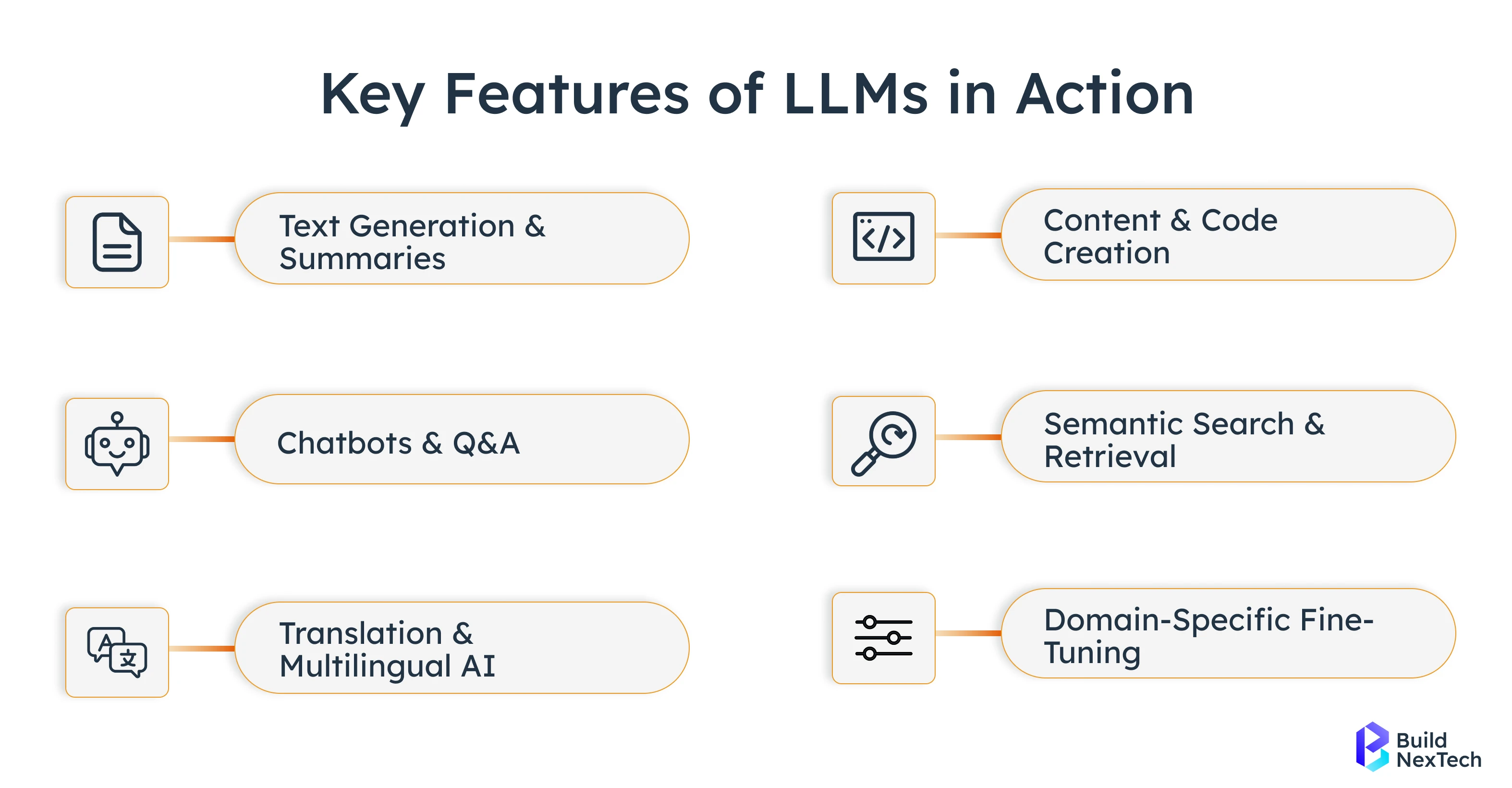In recent years, artificial intelligence (AI) and machine learning have infiltrated every aspect of business, enabling better products, automation, and data-based reasoning. At the center of many of these innovations is the arrival of Large Language Models (LLMs), generative AI technologies that comprehend, create, and interact with human language.
Due to these capabilities, LLMs are becoming increasingly relevant to innovative AI-enabled solutions in areas such as customer service (chatbots), content creation, virtual assistants, predictive analytics, etc. Demand is accelerating: from EdTech to HealthTech firms, from FinTech to enterprise SaaS companies, businesses are rushing to add LLM functionality to their core products. This is where Enterprise LLM Development Services and Customized AI Integration Solutions for Businesses become necessary.
This presents a difficult dilemma for many businesses: should you build your LLM capabilities in-house or hire a third-party provider? Each path has compromises in the form of cost, control, speed, and risk. In this article, we will examine the pros and cons and give advice about how to make a choice.
Understanding LLM Development Services
LLMs are described, and their significance for contemporary AI systems is shown. It shows the way LLMs are the main drivers of chatbots, virtual assistants, and predictive tools, which in turn enhance decision-making and automation. Moreover, the infrastructure, data pipelines, and MLOps required for deployment and scalability are mentioned as a critical need, thus foreshadowing the in-house vs outsourcing debate.
What are LLMs?
Large Language Models (LLMs) are sophisticated deep learning models — usually based on transformers — which are trained on very large text corpora (and sometimes multimodal data) to perform tasks related to language. They have powerful capabilities such as:

They can be used in different applications across sectors. In healthcare, LLMs are used to summarize medical reports or answer patient questions. In finance, they can help summarize earnings calls, ensure compliance, or carry out risk assessments. When creating a customer support chatbot, they can create a virtual assistant or automated response agent. They also can be enhanced with computer vision or multimodal input to create advanced AI agents that combine reasoning from images and text.
The Role of LLM Development Services in Modern Business
LLM Development Services are transforming how organizations build smarter and faster AI systems. These models enhance automation, decision-making, and customer experiences by processing language like humans and predicting outcomes based on data.
To make this possible, businesses need structured data pipelines, scalable MLOps frameworks, and continuous model optimization to ensure performance and accuracy. End-to-End LLM Development Services simplify this process — offering the right infrastructure, technical expertise, and deployment support to turn AI potential into measurable business impact.
AI has moved from a futuristic concept to a business essential. By integrating LLMs, companies gain intelligent interfaces, domain-specific agents, and personalized user interactions — all supported by robust data workflows and monitoring systems that drive growth and innovation. This is why End-to-End AI Application Development Services are so important.
Why In-House LLM Development Can Be Limiting
The present section elaborates on the reasons why internal LLM development could lead to a slowdown in growth and an increase in costs. Among the pointed out challenges are high infrastructure costs, scarce AI-skilled professionals, slow deployment, and compliance costs. Moreover, in-house teams often find it difficult to be updated on the AI tools emerging from the market, which makes the option to outsource more rapid, flexible, and cheaper for many companies.
Disadvantages and Challenges of In-House LLM Development
Building internal LLM squads may appear to be a means for a company to get a step ahead of its competition, yet, at the same time, it would incur large operational and financial cost which could possibly stifle innovation and increase the risk over the long run. The following are the main drawbacks that companies are likely to face when going this route:
- High Costs: Creating an internal AI team demands a lot of money and resources, because it involves investing in hardware, software licenses, and hiring top professionals such as data scientists and machine learning engineers, making it prohibitively expensive for many companies.
- Slow Time-to-Market: Development cycles in-house are long, often delaying product launches, while outsourced AI and machine learning development teams using pre-built frameworks can move faster and deliver results more quickly.
- Limited Innovation: Internal departments often struggle to keep pace with the rapid development of AI tools, AI as a Service platforms, and sophisticated LLM fine-tuning techniques that outsourced partners utilize in their daily operations.
- Infrastructure Overheads: The management of GPUs, cloud infrastructure, and compliance with Data Security and AI regulations can be a source of significant technical and cost burdens.
- Talent Retention Issues: Skilled AI professionals are always in high demand, and losing even one such professional can greatly disrupt the running of the company and increase the costs associated with training new personnel.
- Rigid Operations: Internal systems may turn out to be very rigid, slowing down a company’s ability to adapt to new technologies or hybrid models, unlike custom AI integration solutions for businesses, which offer greater flexibility and faster scalability.
- Maintenance Load: The continuous retraining, monitoring, and management of model drift consume a lot of the already limited time that the engineering team has, thus making them less focused on innovation.
Outsourcing AI Development
AI outsourcing refers to the collaboration with outside vendors to manage AI capabilities instead of creating teams within the company. Skilled suppliers provide services such as creating AI models, integrating them into the company's workflow, providing system maintenance, and developing solutions based on evolving needs.
Two main models of AI outsourcing are available for companies:
- Project-Based Services: Outsourcing partners create custom AI solutions for specific business needs based on projects. This strategy enables testing the waters before committing long-term.
- Managed AI Services: Providers take care of the whole lifecycle of the AI systems of the company, including development, deployment, maintenance, and enhancements. This option gives full lifecycle ownership.
Selecting the right model is based on the sophistication of AI requirements and the level of involvement wanted. The main selling point in both models is to get specialized expertise on demand without incurring recruitment costs for niche skills.
Benefits of Outsourcing LLM Development
- Access to Expertise: Organizations that outsource their AI/ML Development will often have also dedicated specialists in LLM fine-tuning, MLOps, data pipelines, AI agents, and end-to-end solutions. They have the processes in place, rather than having to build everything from scratch.
- Cost Effectiveness & Adaptability: Outsourcing changes fixed costs to variable costs. You can scale up or down, don't incur the cost of hiring employees, and take advantage of price discrepancies. Many companies offer staff augmentation approaches, dedicated teams, or even full outsourcing.
- Quicker Market Entry: Existing data pipelines and teams ready to hit the ground running will reduce the launch time.
- Fewer Overhead Expenses: You can avoid HR, hiring, and the costs of infrastructure, and focus on the application, integration, and product development.
- Fewer Overhead Expenses: You can begin working with outsourced prototypes and gradually bring them in-house, effectively maximizing the benefits of both.
Ensuring Data Security and Project Success in Outsourced LLM Development
Making Outsourced LLM Development Safe and Successful
- Data Protection that is Strong: The best outsourcing partners observe very carefully the NDAs and the worldwide standards such as ISO/IEC 27001, GDPR, and SOC 2. They also apply encryption and access control for the purpose of ensuring complete confidentiality of the data.
- Communication that is Open: Through the use of agile methods and remote communication tools, outsourcing teams are able to provide consistent updates and seamless collaboration across different time zones.
- Accountability that is Shared: Outsourcing does not mean that you lose your control — regular SLAs, dashboards, and review meetings help keep the projects aligned with the goals and quality benchmarks.
- Flexible collaboration: The frameworks that are well-documented allow for easy vendor transitions or shifting projects in-house without long-term dependency.
- Improvement that is Continuous: Outsourcing partners are always improving LLM fine-tuning, AIaaS, and workflows, which gives them the advantage of faster innovation, lower costs, and current AI solutions.

Key Factors to Consider: In-House vs Outsourcing
The outsourcing vs. in-house production evaluation in this section is presented as an alternative scenario, with criteria such as cost, speed, expertise, scalability, and strategic focus being the main determinants for the conclusion. The final verdict is that the outsourcing option plays a more favorable role for the firms aiming at obtaining agility, innovation, and cost savings.
Hybrid Approach: The Best of Both Worlds
The combination of LLM development approaches has a unique feature of being controllable by in-house teams and benefiting from the outsourcing scalability at the same time. It allows corporations to retain the ownership of sensitive information and major AI assets while giving up the remaining parts, such as model training, optimization, and user interface development, to gain quicker output.
This method, which is increasingly adopted in the U.S. and India through the AI as a Service (AIaaS) model, has managed to provide affordable solutions with high innovation as well as maintaining stringent data security. The in-house staff is mainly concerned with the development of the company's position and making sure everything is in line with the regulations, while the external staff offers the use of their proprietary technology and cloud resources to execute the complex AI operations.
This results in quicker time to market, reduced expenditures, and continuous improvement; thus, the hybrid approach becomes the most viable option for businesses looking for agility and long-term scalability, which is the case with a majority of enterprises in the present-day scenario.
Comparing Costs: In-House vs Outsourcing
When deciding between building an in-house LLM team or outsourcing, the cost breakdown plays a major role. Each model impacts financial investment, operational scalability, and time-to-market differently.
In-house developed AI results in deep insights for the company, while outsourcing AI results in speedier deployment and greater flexibility. Many companies use an In-House vs Outsourced AI Development Consultation to inform this decision.

Conclusion
Deciding between in-house development of LLM or outsourced services is dependent on the goals of your organization, but data shows that outsourced services are the most scalable, cost-effective, and future-proof solution for most organizations. Although in-house does provide control and ownership, it is often resource-heavy, slow to adapt, and more difficult to maintain as AI becomes more complex.
On the contrary, outsourcing AI development helps organizations achieve faster results, leverage experts from around the world, and maximize the value of Custom AI Integration Solutions for Businesses without the added burden of unnecessary infrastructure or hiring costs. Outsourcing allows teams to achieve cost savings, shorten time-to-market, and foster continuous innovation through experienced staff and AI-powered solutions.
In short, while in-house development offers independence, the rapidly evolving AI landscape is likely to constrain flexibility. An outsourcing model with end-to-end application AI development services supports a smarter balance of innovation, data security, and scalability that can help organizations innovate faster and be competitive in the global AI market.
People Also Ask
What skills are needed to successfully manage an in-house LLM development team?
Managing an in-house LLM team requires expertise in data engineering, machine learning, and MLOps, along with knowledge of cloud platforms like AWS or Azure. Without these skills, teams may face delays, high costs, and scalability challenges.
How can startups benefit from outsourcing AI and LLM development projects?
Outsourcing helps startups save costs, launch faster, and access experienced AI specialists without building large internal teams. It enables quick scalability through End-to-End AI Application Development Services.
Is data security guaranteed when outsourcing LLM development?
Yes, leading outsourcing firms comply with ISO/IEC 27001, GDPR, and SOC 2 standards. They use NDAs, encryption, and secure cloud infrastructure to keep client data safe and private.
What’s the difference between LLM fine-tuning and training a model from scratch?
Fine-tuning customizes pre-trained models like GPT-3 or LLaMA for your business needs, saving time and cost. Training from scratch is far more resource-intensive, requiring large datasets and high computing power.


























.webp)
.webp)
.webp)

